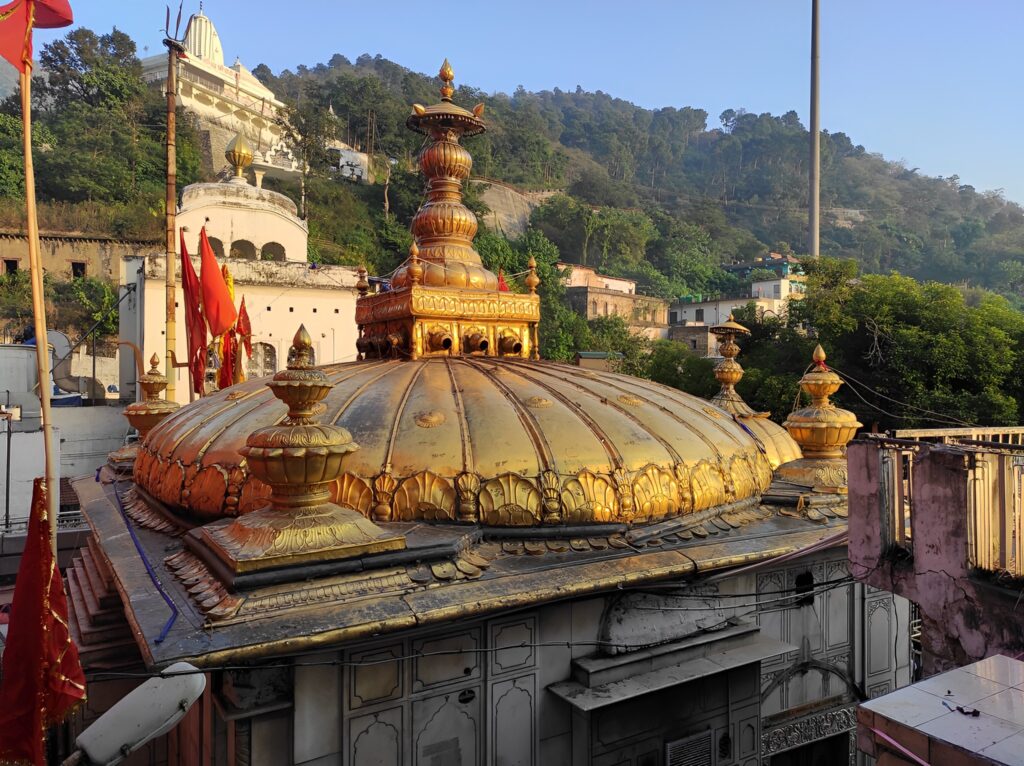
Jwala Devi Temple, one of the 52 Shaktipeeth, is located in the Kangra district of Himachal Pradesh. The eternal flames burning inside the temple are in a palace where visitors pay their offerings. It is a temple that does not have an idol, but the flame burning day and night represent nine forms of the goddess Durga: Annapurna, Mahakali, Hinglaj, Vindhya Vasini, Mahalakshmi, Ambika, Saraswati, Anji Devi, and Chandi.
The Mahakali flame represents devotion and liberation.
The Annapurna Flame bestows bounties on devotees.
Goddess chandi flame destroys opponents
Higalja Bhavani removes the miseries of the devotees.
Vidhasni removes sorrows.
Anji gives age and pleasure.
Goddess Ambika, giver of children.
Goddess Saraswati The goddess is a knowledge god.
The goddess Mahalakshmi gives wealth and success.
Legends
Many mythological stories narrate differences about the origin of temples.
There was once a cowherd who, during grazing, found out that a cow was often without milk. To find a reason, he followed the cow and saw a little girl coming out of a forest and drinking milk. He reported this to Raja Bhumi Chand, who dispatched troops to the palace where Sati’s tongue had fallen. He believed the girl somehow represented Goddess Durga. After some years, he found the flames burning in the temple, and he decided to build a temple named Jwala Devi Temple at the same spot. It’s also believed that Pandavas visited the place and renewed it. The local folk song “Panjan Panjan Pandavan Tera Bhawan Banaya” further cements the belief.
Mughal period
Akbar visited the place and tried to destroy it by extinguishing the flames, but he failed. After that, he offered the goddess a golden chakra or umbrella, but she refused because the gold turned into an unknown metal, signaling the goddess to reject the offering.

Architecture
Jwala Devi Temple is constructed in the Indo-Sikh style, with a small dome on top built on a wooden platform. The main sanctum has eternal flames burning, followed by a pit where visitors offer offerings. The dome of the temple is covered in gold, which was gifted by Maharaja Ranjit Singh. The main door of the temple is covered by silver which was offered by Maharaja Ranjit Singh’s son. The king of Nepal presents the temple’s bell.
Festivals
Jwalamukhi temple Mela is held in the months of Navratri, Chaitra, and Ashwin. During the months of April and October, people offer visits to the mother goddess Jwala ji.
Timings
| Summer | Winter | |
| Temple Opening Time | 5 AM | 6 AM |
| Mangal Arti | 5 AM-6 AM | 6 AM-7 AM |
| Bhog Arti | 11:30 AM-12:30 PM | 11:30 AM-12:30 PM |
| Evening Arti | 7 PM-8 PM | 6 PM-7 PM |
| Shaiyan Arti | 9:30 PM-10 PM | 8:30 PM-9 PM |
| Temple Closing Time | 10 PM | 9 PM |
How to reach Jwala Devi Temple
By Road:
The Jwala Devi Temple is well connected by road to major cities and towns of Himachal Pradesh and other neighboring states. You can hire a taxi or take a bus from nearby cities like Kangra, Dharamshala, Pathankot, and Jammu to reach the temple. The nearest bus stand to the temple is in Kangra, which is about 22 km away.
By Air:
The nearest airport to Jwala Devi Temple is the Gaggal Airport in Kangra, which is about 34 km away. You can take a taxi or a bus from the airport to reach the temple.
By Train:
The nearest railway station to Jwala Devi Temple is in Kangra, which is about 20 km away. You can take a taxi or a bus from the railway station to reach the temple.
